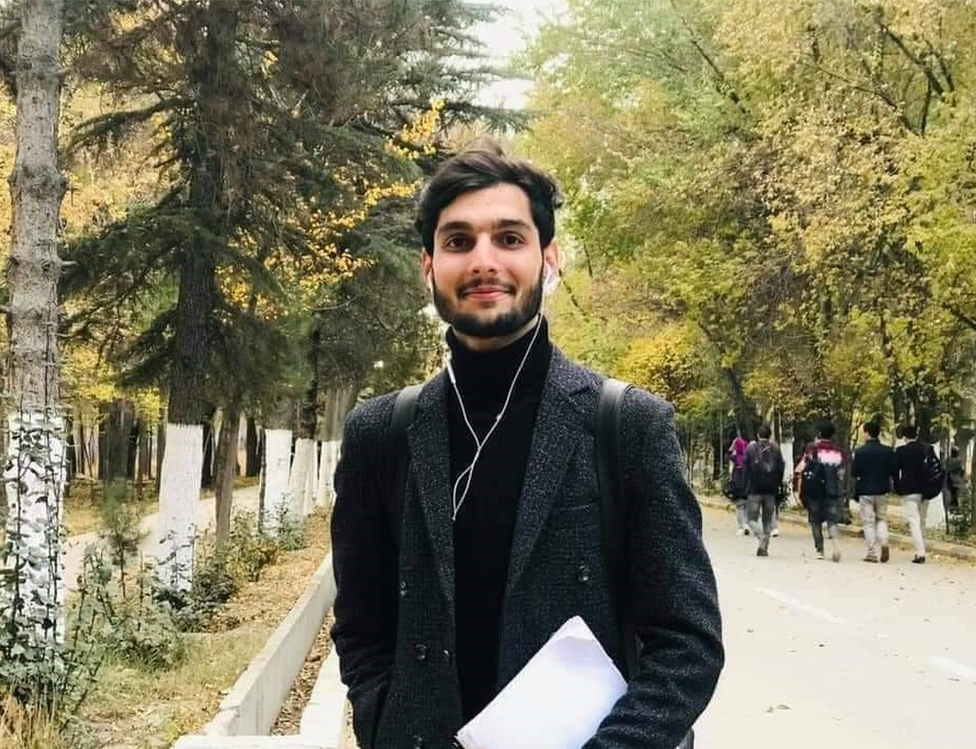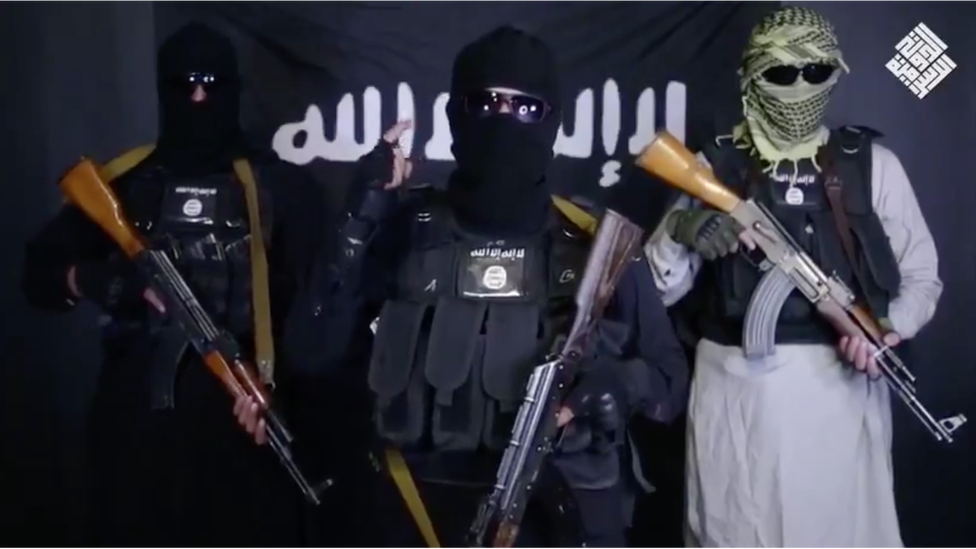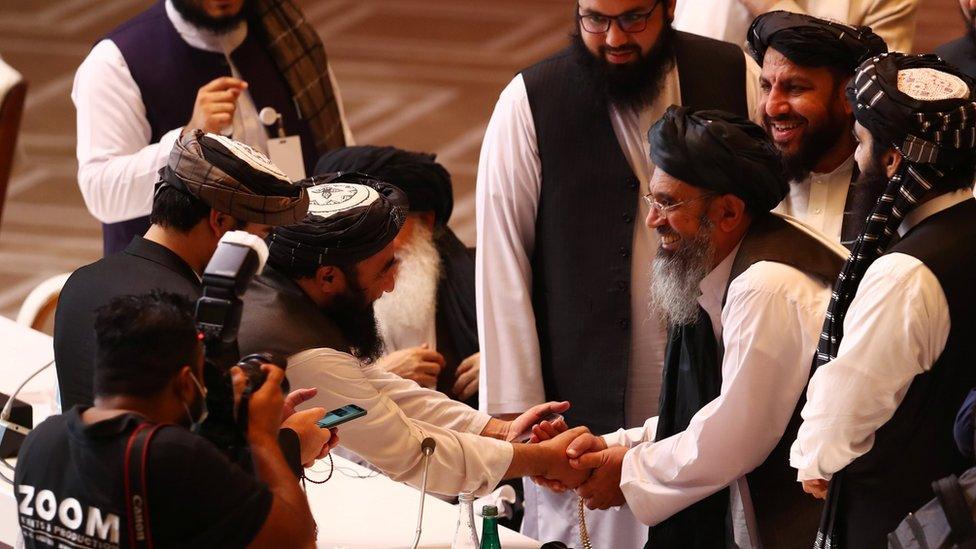Afghanistan conflict: IS links to Kabul student killings cause outrage
- Published

Mohammad Rahid had his life ahead of him, but died aged 22
Mohammad Rahid's warm and cheerful expression radiates through a motivational video clip that has been widely shared online following his death.
"Life is full of challenges, pain, sadness, pressures and problems," he says, "but still, there is a smile on these lips."
On Monday the 22-year old student was among more than 20 people killed in an attack by gunmen on Kabul University, one of Afghanistan's oldest and most popular institutions. The assault on young men and women trying to build a future for themselves and their country has shaken the city's residents and caused outrage. It's hard to comprehend who could commit such cold-hearted murders.
The Islamic State group has claimed responsibility, releasing a photograph of two masked attackers, who, it said, targeted a ceremony for "the graduation of judges and investigators".
Gunshots heard as students try to escape the Kabul University
IS is the latest player to emerge in the murky world of militants in the country, further complicating the already bloody war between the Afghan government and Taliban insurgents. It's far less powerful than the Taliban and recently lost most of the territory it once controlled in the east of the country, but it retains the ability to carry out deadly attacks.
Both the Taliban and the government have fought against IS and both regard it with suspicion, accusing each other of secretly supporting the jihadists and using them to undermine slow-moving peace talks.
Questions over 'Taliban flag'
That war of narratives over IS has come to the fore in the aftermath of this awful attack.
Amrullah Saleh, the first vice-president of Afghanistan, and a vocal critic of the Taliban, described the IS statement as "fake", stating that the weapons found at the scene do not match those in the photo released by IS. Mr Saleh also pointed to a "Taliban flag" apparently found at the scene of the attack as evidence that the Taliban - rather than IS - carried it out.

The video purportedly retracting the IS claim is thought to be fake
Journalists visiting the site took photographs of the specifically pro-Taliban slogan "Long live the Emirate" scrawled on the bullet-ridden wall of a classroom.
There was a further mysterious development, when a video was uploaded to the internet, purportedly of masked IS militants denying they were involved in the attack, and blaming the Taliban.
Most experts, however, agree the video is a fake. And it remains unclear why, if the Taliban wanted to avoid association with the attack, they would bring a flag with them to the scene.
Taliban spokesman Zabiullah Mujahid issued an angry rebuttal, asking: "How is it possible for assailants to find the time to draw graffiti on walls while being engaged in combat? And what purpose would taking a flag to attack site serve?"
A Taliban statement condemned the attack, and accused the government of supporting IS, suggesting it had encouraged the group to stage the assault for "propaganda" purposes. The Taliban's criticism of the violence rings rather hollow, however, as they are widely believed to have carried out an assault on another university in the city in 2016, in which 13 people were killed.
Borhan Osman, a senior analyst who has conducted extensive research into the Afghan conflict, told the BBC that both sides have "strongly held" narratives about IS but there has been no real evidence substantiating the claims advanced by either the Taliban or the government.
The counter-accusations mirror similar claims by both sides about IS in the past too.
Supporters of the government have often accused the Taliban of carrying out attacks on "soft targets" but deliberately not claiming them, and allowing IS to take responsibility instead, in order to benefit from the chaos of the violence whilst avoiding the public backlash.
Is peace with the Taliban possible?
There is something of a precedent for this: suicide attacks with large numbers of civilian casualties, widely thought to have been carried out by the Taliban, and its affiliated Haqqani network, have at times gone unclaimed.
However, the Taliban have fought fiercely against IS in eastern Afghanistan, determined not to allow them to usurp their position in the insurgency. The Taliban have claimed the Afghan government helped rescue IS fighters during clashes between the two militant groups in the north. Afghan officials deny that.
There's no doubt that the conflict with the Taliban saps some of the energy that the government could be expending on tackling IS, and for a war-weary public, divisions between the militants seem irrelevant in the face of widespread violence.
Security officials in Kabul also have said they believe, despite the Taliban's rivalry with IS, that the two groups tap into the same logistical support networks when carrying out attacks in the city.
But there are also apparently significant ideological differences between the groups.
The Taliban profess to only wanting to implement an "Islamic government" or "Islamic Emirate within Afghanistan", and insist they do not pose a threat to other countries, whereas the Afghan branch of IS flaunts its links with affiliates in the Middle East and the idea of a global "caliphate".
IS has also been much more openly sectarian, repeatedly targeting Kabul's Shia minority in bloody suicide bombings on weddings, shrines and sports clubs in a way the Taliban have not. Last month IS killed more than 20 students outside a tuition centre in a Kabul neighbourhood largely populated by ethnic Hazaras, followers of Shia Islam whom IS regard as heretics.
IS 'recruiting middle-class youth'
In an interview two years ago, one IS prisoner held in a Kabul prison told the BBC the group considered itself the only "real Muslims", following, in their view, a true, undiluted interpretation of the religion, which they contrasted to the Taliban's more nationalist-infused views. He dismissed the Taliban as "agents" of the Pakistani intelligence services.
Research by Borhan Osman for the United States Peace Institute also indicates that around Kabul at least, IS has managed to recruit from sectors of the population not typically drawn to the Taliban, such as "men and women from middle-class families, many of whom are non-Pashtun university students".
One of the attackers at Kabul University was referred to by IS using the nom de guerre "Anas al Banishiri", suggesting a link to Panjshir province, traditionally a stronghold of anti-Taliban sentiment. By contrast, Mr Osman wrote, the Taliban generally receive support from more rural and ethnically Pashtun communities.

Peace talks began last month but since then violence has worsened
The horrific violence carried out by IS has the potential to disrupt the already stalling peace talks between Afghan officials and the Taliban, with the bloodshed further raising tensions and increasing disillusionment amongst the public.
And whilst predictions that IS could attract defections from hard line elements in the Taliban opposed to the peace process have so far failed to materialise, the attacks also highlight the continued danger the group could pose, even if an agreement between the two main warring parties is eventually reached.
Mr Osman told the BBC the competing narratives over IS mean "there is a risk of overlooking the actual threat, however small, that comes from urban youth who are well-educated and have become radicalised". At the moment, he said, "there is very little appetite in acknowledging or doing anything about this threat".

You may also be interested in:
Ogai Wardak, 18: "If the Taliban come, I will fight them"
- Published2 November 2020
